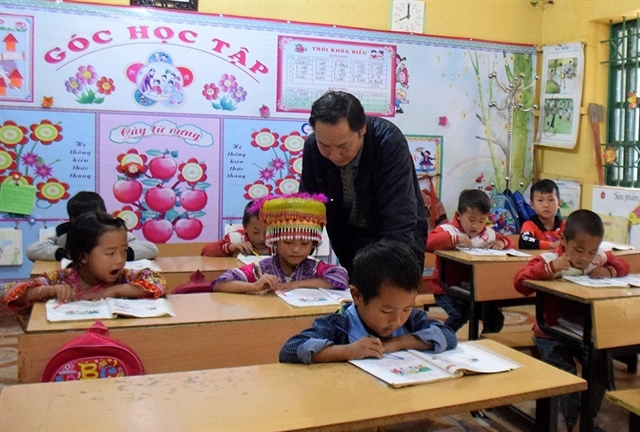
LÀO CAI — A mountainous border province with many difficulties, Lào Cai has achieved important results in the education and training of ethnic minority students.
Successful projects on strengthening the Vietnamese language for preschool children and primary school students in ethnic minority areas in 2016-20 have made important contributions to the local education sector.
Việt Nam is a multi-ethnic and multilingual country and Vietnamese is a common language, alongside different languages of 53 other ethnic groups.
More and more ethnic minority students in Lào Cai Province have achieved high results in the district, provincial and national competitions.
In the 2020-21 school year, two Dao group students at the A Mú Sung Primary and Secondary School for Ethnic Minorities, Bát Xát District, won the special prize in the national Children Innovation Contest, the first time Lào Cai students have won the award.
In 2018, 2019 and 2021, a group of students from the Semi-boarding School for Ethnic Minorities, Primary School No 1 in Si Ma Cai District won the first and second prizes in the “Youth Innovative” contest for teenagers and children nationwide.
Bùi Thị Hường, the school’s principal, said that out of 315 students in the school, there was only one Kinh student – the most common group in the country. Eighty per cent of the school’s students are Mông ethnic minorities.
In previous generations, students who went to school could speak little Vietnamese and most were shy and dare not to talk to strangers.
In recent years, the students have been learning Vietnamese intensively and studying the Vietnamese-Mông bilingual curriculum, so not only can they read, write and speak the Mông language well, but also Vietnamese.
Determining that language and thinking cannot exist separately, Hường said that with the motto “Vietnamese is the prerequisite for quality,” the school organised educational activities with a multicultural school model.
It also regularly organised extracurricular activities, creating a good environment for students to have fun and communicate.
Vy Thị Tố Uyên, principal of the Tả Phìn Kindergarten in Sa Pa Town, said that first of all the school requires that all teachers can speak the local languages, mainly Mông and Dao. This will help them in communication and bilingual teaching for students.
The school focuses on encouraging parents to understand the importance of improving Vietnamese for five-year-old preschool children when they are about to enter grade one and parents’ rights and responsibilities in creating favourable conditions for the children.
The school encourages families to communicate with their children in Vietnamese at home. It pays special attention to building a Vietnamese language environment outside the classroom by increasing the amount of extra-curricular activities.
The school requires teachers of five-year-old children to regularly exchange expertise with teachers of grade one.
Uyên also said that in the next school year, the school will have 87 children entering grade one. All can speak Vietnamese fluently. This is a solid foundation for the children to quickly access the new grade one curriculum and textbooks.
Increase resources
To improve Vietnamese for students, many localities in Lào Cai have increased investment in teaching and learning equipment, perfecting the Vietnamese language education environment.
Over the years, with local budget and contributions from parents and financial support from sponsors, Si Ma Cai District has spent nearly VNĐ15.5 billion (US$684,960) to buy books and teaching aids in the Vietnamese language.
To improve the quality of teaching Vietnamese, the key solution is to improve teaching quality. Since 2016, the district Education and Training Department and schools have organised 38 training classes and 32 seminars for administrators and teachers during the school year and summer holidays.
Deputy director of the department Nhâm Tiến Đức said that all of the primary school students in the district had strengthened in the Vietnamese language.
Ten schools in the district successfully built a model strengthening the Vietnamese language for ethnic minority students.
“The department will regularly examine, evaluate, learn from experience and share good practices and effective solutions to help ethnic minority students learn the Vietnamese language better,” said Đức.
This year, the Lào Cai Department of Education and Training has set a target of having all children in kindergartens strengthen their Vietnamese language.
Schools will provide appropriate documents, learning materials, pictures and tapes for children, and pay more attention to building a Vietnamese communication environment for ethnic minority students. — VnExpress News
- Reduce Hair Loss with PURA D’OR Gold Label Shampoo
- Castor Oil Has Made a “Huge” Difference With Hair and Brow Growth
- Excessive hair loss in men: Signs of illness that cannot be subjective
- Dịch Vụ SEO Website ở Los Angeles, CA: đưa trang web doanh nghiệp bạn lên top Google
- Nails Salon Sierra Madre
 VnExpress News The News Gateway of Vietnam
VnExpress News The News Gateway of Vietnam





